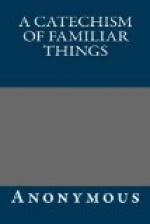Primeval, original, existing before the flood.
Gigantic, extremely large, greater than the usual size.
Interment, burial under the ground.
Elements, the
several parts or principles of which bodies
are composed.
What is a Coal Mine?
A subterraneous excavation, from which coal is obtained.
Do the terms Coal and Charcoal signify the same substance?
No; Charcoal is an artificial fuel, made in imitation of coal, by burning wood covered with earth so as partially to exclude the air. It is used for various purposes, as the making of gunpowder,[7] polishing brass and copper, &c., and when a clear and bright fire is required, as it burns with little or no smoke; it is dangerous, however, for one to remain many hours in a close room with a charcoal fire, as the fumes it throws out are hurtful, and would destroy life. Charcoal, in fact, is the coaly residuum of any vegetables burnt in close vessels; but the common charcoal is that prepared from wood, and is generally black, very brittle, light, and destitute of taste or smell. It is a powerful antiseptic, unalterable and indestructible.
[Footnote 7: See Chapter XII.]
Residuum, the remaining part, that which is left.
Antiseptic, that which prevents putrefaction.
What is Iron?
One of the most useful and abundant metals; being found in all mineral earths, and stones; in plants, and animal fluids; and is the chief cause of the varieties of color in all. Iron is found in great masses, in various states, in the bowels of the earth; it is usually, however, compounded with stone, from which it is separated by the action of fire. In some parts of the world, whole mountains are formed of iron; among these may be mentioned the Pilot Knob and the Iron Mountain, in Missouri, being unsurpassed by anything of the kind found elsewhere.
What are its characteristics?
It is hard, fusible, not very malleable, but extremely ductile, and very tenacious; it is of a greyish color, and nearly eight times heavier than water. Without iron, society could make no progress in the cultivation of the ground, in mechanical arts or trades, in architecture or navigation; it is therefore of the greatest use to man. Iron tools have been used in all European countries as long as their histories have existed; this metal appears likewise to have been known and used by the inhabitants of the world in the earliest ages, being frequently mentioned in the Holy Scriptures. In the fourth chapter of Genesis, Tubalcain is spoken of as “a hammerer and artificer in every work of brass and iron,” and thus their existence was evidently known at that early period of the world.
Artificer, one who works or makes.
Fusible, capable of being melted by fire.




